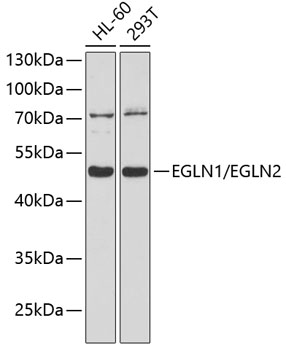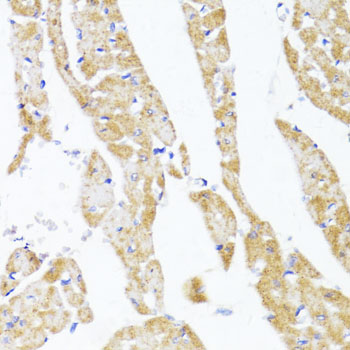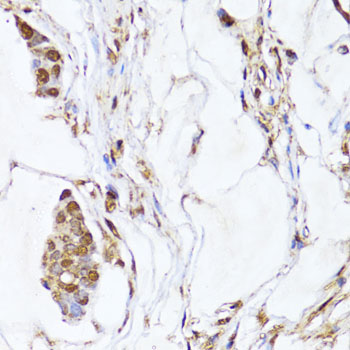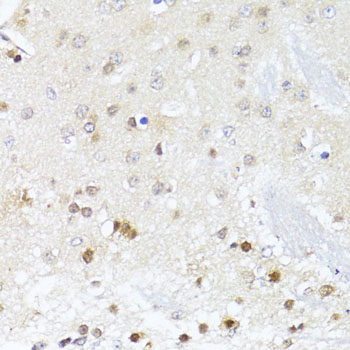Anti-EGLN1/EGLN2 Antibody (CAB10342)
- SKU:
- CAB10342
- Product type:
- Antibody
- Reactivity:
- Human
- Mouse
- Rat
- Host Species:
- Rabbit
- Isotype:
- IgG
- Antibody Type:
- Polyclonal Antibody
- Research Area:
- Cell Biology
Description
| Antibody Name: | Anti-EGLN1/EGLN2 Antibody |
| Antibody SKU: | CAB10342 |
| Antibody Size: | 20uL, 50uL, 100uL |
| Application: | WB IHC |
| Reactivity: | Human, Mouse, Rat |
| Host Species: | Rabbit |
| Immunogen: | A synthetic peptide of human EGLN1/EGLN2 |
| Application: | WB IHC |
| Recommended Dilution: | WB 1:500 - 1:2000 IHC 1:50 - 1:200 |
| Reactivity: | Human, Mouse, Rat |
| Positive Samples: | HL-60, 293T |
| Immunogen: | A synthetic peptide of human EGLN1/EGLN2 |
| Purification Method: | Affinity purification |
| Storage Buffer: | Store at -20°C. Avoid freeze / thaw cycles. Buffer: PBS with 0.02% sodium azide, 50% glycerol, pH7.3. |
| Isotype: | IgG |
| Sequence: | Email for sequence |
| Gene ID: | 54583/112398 |
| Uniprot: | Q9GZT9/Q96KS0 |
| Cellular Location: | |
| Calculated MW: | 36kDa/43kDa/46kDa/40kDa |
| Observed MW: | 44kDa |
| Synonyms: | EGLN1/EGLN2 |
| Background: |
| UniProt Protein Function: | EGLN1: Cellular oxygen sensor that catalyzes, under normoxic conditions, the post-translational formation of 4-hydroxyproline in hypoxia-inducible factor (HIF) alpha proteins. Hydroxylates a specific proline found in each of the oxygen-dependent degradation (ODD) domains (N-terminal, NODD, and C-terminal, CODD) of HIF1A. Also hydroxylates HIF2A. Has a preference for the CODD site for both HIF1A and HIF1B. Hydroxylated HIFs are then targeted for proteasomal degradation via the von Hippel-Lindau ubiquitination complex. Under hypoxic conditions, the hydroxylation reaction is attenuated allowing HIFs to escape degradation resulting in their translocation to the nucleus, heterodimerization with HIF1B, and increased expression of hypoxy-inducible genes. EGLN1 is the most important isozyme under normoxia and, through regulating the stability of HIF1, involved in various hypoxia-influenced processes such as angiogenesis in retinal and cardiac functionality. Monomer. Interacts with ING4; the interaction inhibits the hydroxylation of HIFs. Interacts with LIMD1. Found in a complex composed of LIMD1, VHL, EGLN1/PHD2, TCEB2 AND CUL2. Interacts with EPAS1. According to PubMed:11056053, widely expressed with highest levels in skeletal muscle and heart, moderate levels in pancreas, brain (dopaminergic neurons of adult and fetal substantia nigra) and kidney, and lower levels in lung and liver. According to PubMed:12351678 widely expressed with highest levels in brain, kidney and adrenal gland. Expressed in cardiac myocytes, aortic endothelial cells and coronary artery smooth muscle. According to PubMed:12788921; expressed in adult and fetal heart, brain, liver, lung, skeletal muscle and kidney. Also expressed in placenta. Highest levels in adult heart, brain, lung and liver and fetal brain, heart spleen and skeletal muscle. Following exposure to hypoxia, activated in HeLa cells but not in cardiovascular cells. 3 isoforms of the human protein are produced by alternative splicing. |
| UniProt Protein Details: | Protein type:EC 1.14.11.29; Oxidoreductase Chromosomal Location of Human Ortholog: 1q42.1 Cellular Component: cytoplasm; cytosol; nucleus Molecular Function:peptidyl-proline dioxygenase activity; protein binding; enzyme binding; L-ascorbic acid binding; iron ion binding; oxidoreductase activity, acting on paired donors, with incorporation or reduction of molecular oxygen, 2-oxoglutarate as one donor, and incorporation of one atom each of oxygen into both donors; peptidyl-proline 4-dioxygenase activity Biological Process: oxygen homeostasis; negative regulation of cAMP catabolic process; negative regulation of transcription factor activity; cardiac muscle morphogensis; response to hypoxia; peptidyl-proline hydroxylation to 4-hydroxy-L-proline; negative regulation of cyclic-nucleotide phosphodiesterase activity; regulation of angiogenesis Disease: Erythrocytosis, Familial, 3; Hemoglobin, High Altitude Adaptation |
| NCBI Summary: | The protein encoded by this gene catalyzes the post-translational formation of 4-hydroxyproline in hypoxia-inducible factor (HIF) alpha proteins. HIF is a transcriptional complex that plays a central role in mammalian oxygen homeostasis. This protein functions as a cellular oxygen sensor, and under normal oxygen concentration, modification by prolyl hydroxylation is a key regulatory event that targets HIF subunits for proteasomal destruction via the von Hippel-Lindau ubiquitylation complex. Mutations in this gene are associated with erythrocytosis familial type 3 (ECYT3). [provided by RefSeq, Nov 2009] |
| UniProt Code: | Q9GZT9 |
| NCBI GenInfo Identifier: | 32129514 |
| NCBI Gene ID: | 54583 |
| NCBI Accession: | Q9GZT9.1 |
| UniProt Related Accession: | Q9GZT9 |
| Molecular Weight: | |
| NCBI Full Name: | Egl nine homolog 1 |
| NCBI Synonym Full Names: | egl-9 family hypoxia inducible factor 1 |
| NCBI Official Symbol: | EGLN1 |
| NCBI Official Synonym Symbols: | HPH2; PHD2; SM20; ECYT3; HALAH; HPH-2; HIFPH2; ZMYND6; C1orf12; HIF-PH2 |
| NCBI Protein Information: | egl nine homolog 1 |
| UniProt Protein Name: | Egl nine homolog 1 |
| UniProt Synonym Protein Names: | Hypoxia-inducible factor prolyl hydroxylase 2; HIF-PH2; HIF-prolyl hydroxylase 2; HPH-2; Prolyl hydroxylase domain-containing protein 2; PHD2; SM-20 |
| UniProt Gene Name: | EGLN1 |
| UniProt Entry Name: | EGLN1_HUMAN |






